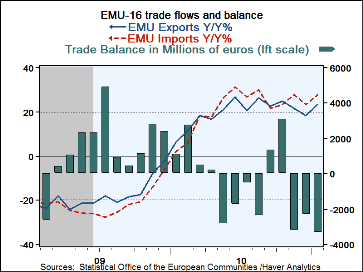 Global| Mar 18 2011
Global| Mar 18 2011EMU Trade Stays in Deficit
Summary
In Europe, Euro-Area trade flows are mostly steady with Yr/Yr growth rates in excess of 20%. The balance of trade had swung back into deficit three months ago and it remains there. Exports and imports each are losing a slight bit of [...]
 In Europe, Euro-Area trade flows are mostly steady with Yr/Yr growth rates in excess of 20%. The balance of trade had swung
back into deficit three months ago and it remains there. Exports and imports each are losing a slight bit of momentum in their
yr/yr growth rates, but that picture has not changed much. Shorter term horizons still show elevated and even accelerating rates of growth.
In Europe, Euro-Area trade flows are mostly steady with Yr/Yr growth rates in excess of 20%. The balance of trade had swung
back into deficit three months ago and it remains there. Exports and imports each are losing a slight bit of momentum in their
yr/yr growth rates, but that picture has not changed much. Shorter term horizons still show elevated and even accelerating rates of growth.
Europe is still growing solidly. It continues to be led by growth in Germany. It has a creeping conundrum about where to focus monetary policy as growth in the area is still uneven but inflation has begun to rise, especially in its fastest growing large economy, Germany.
Problems are somewhat worse in the UK which is not in the e-zone. The UK has been ignoring and treating as temporary its growing inflation overshoot. But a recent survey has found that inflation expectations in the UK are starting to rise. That development will rip the ability to be flexible right out of the BOE’s policy options.
This is a situation that the ECB will want to avoid. The BOE dilemma will undoubtedly play into the hands of the hawks on the ECB. Still this dilemma is not a topical issue for the moment as events in the Middle East, Libya especially, and ongoing disasters in Japan have shifted the global focus elsewhere and largely away from policy making. But this past week the G-7 has been empowered to step in and help Japan in its time of need by agreeing to stem disorderly exchange market developments with the yen.
Perhaps we are not too far removed from having economic policy come back into focus.
| Euro-Area Current Account Major Components | ||||||
|---|---|---|---|---|---|---|
| Month-to-Month | Period Changes | |||||
| Mlns, euros,sa | Jan-11 | Dec-10 | Nov-10 | 3-Mos | 6-Mos | 12-Mos |
| Current Account | -700 | -12,500 | -10,500 | 8,800 | 3,400 | -2,200 |
| Goods Balance WDA | -3,300 | -2,318 | -3,234 | -6,382 | -2,798 | -4,415 |
| Services Balance | 4,000 | -700 | 4,500 | 2,200 | 600 | 1,100 |
| Income Balance | 500 | -4,100 | -4,300 | 2,500 | -1,300 | -1,300 |
| Current transfers | -6,500 | -8,100 | -6,500 | 300 | 4,100 | 700 |
| Detail- % | ||||||
| Goods | Month-to-Month | At Annual Rates | ||||
| Exports | 8.5% | -0.9% | 2.1% | 45.4% | 24.1% | 23.0% |
| Imports | 7.6% | -3.9% | 3.4% | 30.3% | 24.2% | 25.8% |
| Services | ||||||
| Exports | 10.0% | -8.5% | 8.2% | 40.7% | 8.5% | 11.6% |
| Imports | -1.2% | 3.0% | 1.8% | 14.8% | 6.1% | 9.9% |
Robert Brusca
AuthorMore in Author Profile »Robert A. Brusca is Chief Economist of Fact and Opinion Economics, a consulting firm he founded in Manhattan. He has been an economist on Wall Street for over 25 years. He has visited central banking and large institutional clients in over 30 countries in his career as an economist. Mr. Brusca was a Divisional Research Chief at the Federal Reserve Bank of NY (Chief of the International Financial markets Division), a Fed Watcher at Irving Trust and Chief Economist at Nikko Securities International. He is widely quoted and appears in various media. Mr. Brusca holds an MA and Ph.D. in economics from Michigan State University and a BA in Economics from the University of Michigan. His research pursues his strong interests in non aligned policy economics as well as international economics. FAO Economics’ research targets investors to assist them in making better investment decisions in stocks, bonds and in a variety of international assets. The company does not manage money and has no conflicts in giving economic advice.






